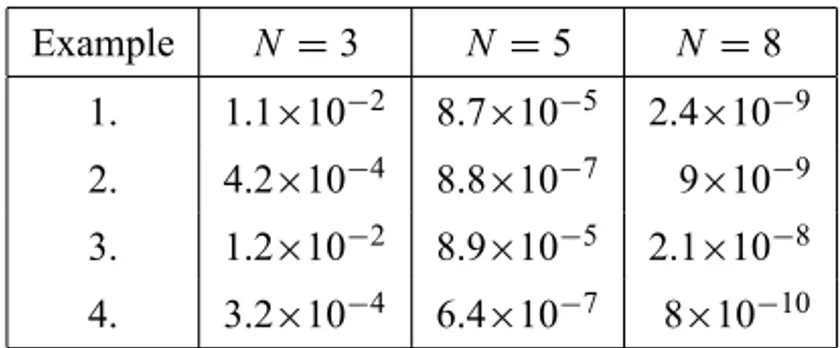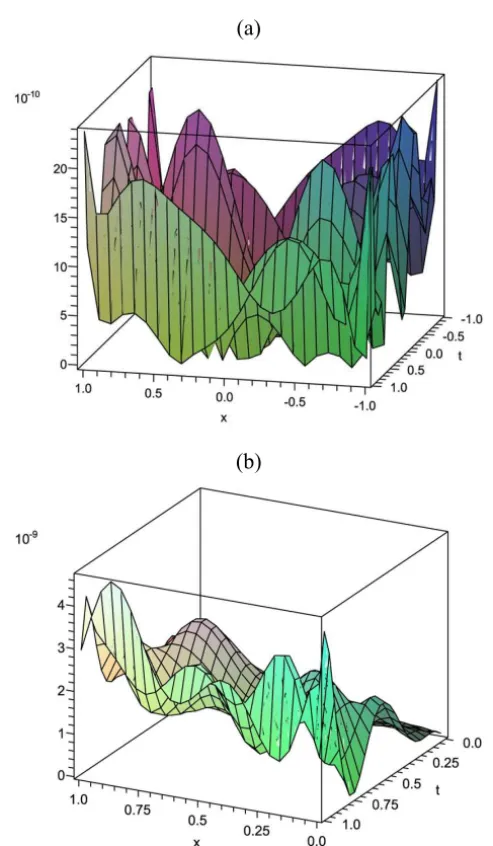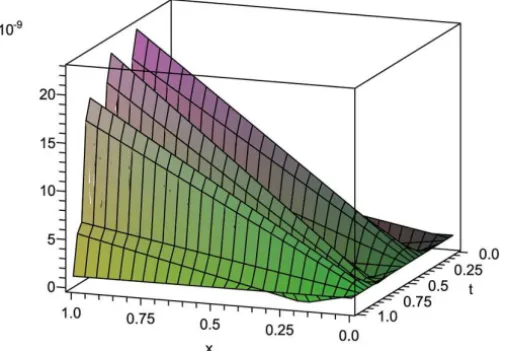ISSN 0101-8205 / ISSN 1807-0302 (Online) www.scielo.br/cam
Chebyshev polynomials for solving two dimensional
linear and nonlinear integral equations
of the second kind
ZAKIEH AVAZZADEH* and MOHAMMAD HEYDARI
Faculty of Science, Islamic Azad University, Yazd Branch, Yazd, Iran E-mails: z.avazzadeh@yahoo.com / m.heydari85@gmail.com
Abstract. In this paper, an efficient method is presented for solving two dimensional Fred-holm and Volterra integral equations of the second kind. Chebyshev polynomials are applied to approximate a solution for these integral equations. This method transforms the integral equation
to algebraic equations with unknown Chebyshev coefficients. The high accuracy of this method
is verified through some numerical examples.
Mathematical subject classification: 65R20, 41A50, 41A55, 65M70.
Key words:Chebyshev polynomials, two dimensional integral equations, collocation method.
1 Introduction
Two dimensional integral equations provide an important tool for modeling a numerous problems in engineering and science [2, 12]. These equations appear in electromagnetic and electrodynamic, elasticity and dynamic contact, heat and mass transfer, fluid mechanic, acoustic, chemical and electrochemical process, molecular physics, population, medicine and in many other fields [6, 7, 8, 14, 18, 20].
The Nystrom method [10] and collocation method [3, 21] are the most impor-tant approaches of the numerical solution of these integral equations. Recently,
some new methods such as differential transform method are applied for solv-ing two dimensional linear and nonlinear Volterra integral equations [1, 5, 19].
In this work, we will apply the Chebyshev polynomials for solving two dimen-sional integral equations of second kind. The use of the Chebyshev series for the numerical solution of linear integral equations has previously been discussed in [17] and references therein. The privilege of the method is simplicity and spectral accuracy [4, 11]. The examples confirm that the method is considerably fast and highly accurate as sometimes lead to exact solution. Also, this method lead to continuous solution covering all the domain.
The paper is organized in the following way. In Section 2 the famous Cheby-shev polynomials and its application are introduced [16]. In Section 3 the method of solution of the linear two dimensional integral equation of second kind is described. In Section 4 we will try to generalize this method for nonlinear cases. In Section 5 some examples are chosen to show the ability and high accuracy of the method.
2 Chebyshev polynomials
Definition 1. If t =cosθ (06θ 6π ), the function
Tn(t)=cos(nθ )=cos(narccost), (1)
is a polynomial of t of degree n(n = 0,1,2, . . .). Tn is called the Chebyshev polynomial of degree n [16]. Whenθ increase from0toπ , t decrease from1
to−1. Then the interval[−1,1]is domain of definition of Tn(t). It satisfies the orthogonality condition
Z 1
−1
Tn(x)Tm(x)
√
1−x2 =
0, n 6=m, π
2, n =m6=0,
π, n =m=0
(2)
Remark 1 (Chebyshev series expansion). Let beg(x) a function on[a,b]. For a given arbitrary natural number M, Chebyshev series expansion of g(x) have the form
g(x)≃
M
X
k=0 akTk
2
b−ax− b+a b−a
where
ak = 2
πck
Z 1
−1
g b−2ax+ b+2a
Tk(x)
√
1−x2 d x, k =1,2,∙ ∙ ∙ ,M. (4)
and
ck =
2, k =0, 1, k ≥1.
(5)
Definition 2. Suppose f(x,t)be a continuous function on[−1,1] × [−1,1]. For a given natural number N , we set
f(x,t)≈
N
X
i=0 N
X
j=0
ai jTi(x)Tj(t), (x,t)∈ [−1,1] × [−1,1], (6)
where
ai j =
Ti(x),f(x,t),Tj(t)
hTi(x),Ti(x)i.Tj(t),Tj(t), (7)
andh∙,∙idenotes the inner product in function space L2(
[−1,1] × [−1,1]). Remark 2. This paper discusses using Chebyshev polynomials of the first kind to approximate functions on finite interval, that is, on the interval[−1,1]. Practically, other polynomials, which are orthogonal on finite interval, can also be applied for approximating functions. But the partial sums of a first-kind Chebyshev expansion of a continuous function in[−1,1]cover faster than the partial sums of an expansion in any other orthogonal polynomials [16].
3 Solution of linear two dimensional integral equation
Consider the two dimensional linear Fredholm and Volterra integral equations as follows
u(x,t)− Z 1
−1
Z 1
−1
k(x,t,y,z)u(y,z)d yd z= f(x,t), (x,t)∈ [−1,1] × [−1,1],
and
u(x,t)− Z t
−1
Z x
−1
k(x,t,y,z)u(y,z)d yd z= f(x,t), (x,t)∈ [−1,1] × [−1,1],
(9)
where u(x,t) is an unknown scalar-valued function, f(x,t) and k(x,t,y,z) are continuous functions on [−1,1]2 and
[−1,1]4 respectively. For the case
which integration domain is[a,b] × [c,d], we can use suitable change of vari-able to obtain these intervals.
At first, we consider two dimensional linear Fredholm integral equations are defined in (4). Function u(x,t) defined over [−1,1] × [−1,1] may be rep-resented by Chebyshev series as
u(x,t)=
∞
X
i=0
∞
X
j=0
ai jTi(x)Tj(t), (x,t)∈ [−1,1] × [−1,1]. (10) If the infinite series in (6) is truncated, then (6) can be written as
u(x,t)≈uN(x,t)=
N
X
i=0 N
X
j=0
ai jTi(x)Tj(t), (11) whereN is any natural number. The method of collocation solves the (4) using the approximation (7) through the equations
RN(xr,ts) = uN(xr,ts)− Z 1
−1
Z 1
−1
k(xr,ts,y,z)uN(y,z)d yd z −f(xr,ts)=0,
(12)
for Gauss-Chebyshev-Lobatto as collocation points [16]
xr =cosrπ
N
, r =0,1, . . . ,N,
ts =cossπ
N
, s =0,1, . . . ,N.
(13)
The interested reader can see more detail of collocation method in [3, 4, 11]. Similarly, function k(xr,ts,y,z) can be expressed as truncated Chebyshev series in the following form
k(xr,ts,y,z)≈kM(xr,ts,y,z)=
M
X
p=0 M
X
q=0
for any natural numberM. From (3) we have
k(pqr,s) =
4 π2cpcq
Z 1
−1
Z 1
−1
k(xr,ts,y,z) p
1−y2√1−z2Tp(y)Tq(z)d yd z, (15)
where
cp=
2 p =0, 1 p ≥1.
By using Gauss-Chebyshev-Lobatto integration rule [13], for a given natural numbernwe have
k(pqr,s) =
4
n2c pcq
n X′′
ξ=0 n X′′
η=0 k
xr,ts,cos
ξ π n ,cos
ηπ n
cos
pξ π
n
cosqηπ
n
, (16)
where double prime denotes that the first and the last terms are halved. Now, by substituting (7) and (10) into (8) we obtain
N
X
i=0 N
X
j=0
ai jψi jr s− f(xr,ts)=0. (17)
where
ψi jr s =Ti(xr)Tj(ts)−
M
X
p=0 M
X
q=0 k(pqr,s)
Z 1
−1
Z 1
−1
Ti(y)Tj(z)Tp(y)Tq(z)d yd z
.
We define
b(i jr,s) = Ti(xr)Tj(ts), (18)
fr s = f(xr,ts), (19)
and
w(pqi,j) = Z 1
−1
Ti(y)Tp(y)d y
Z 1
−1
Tj(z)Tq(z)d z
. (20)
But the Chebyshev polynomials are even for even degree and odd for odd degree. Hence,
Z 1
−1
Ti(x)Tp(x)d x =
1
1−(i+p)2 +
1
1−(i−p)2 i+p is even,
0 i+p is odd.
So, from (13), (14), (15) and (16) we can obtain the system of linear equations,
N
X
i=0 N
X
j=0
ai jw˜(i jr,s) = fr s, r,s =0,1,2, . . . ,N, (22)
wherew˜(i jr,s)is computed by the following relation
˜
w(i jr,s)=b(i jr,s)− M
X
p=0 M
X
q=0
k(pqr,s)w(pqi,j), i,j =0,1, . . . ,N. (23)
Clearly, the obtained system contains(N+1)2equations in the same number as unknowns. It can be solved by Newton’s iteration method to obtain the value of
ai j such thati, j=0. . .N.
For the Volterra case, this method is valid. We just change (16) with the fol-lowing equation
w(pqi,j,r,s)= Z xr
−1
Ti(y)Tp(y)d y
Z ts
−1
Tj(z)Tq(z)d z
, (24)
so that, if let
τi p(x)=
Z x
−1
Ti(y)Tp(y)d y, we will have
τi p(x)=
1 4
2x2 −2
Ti+p+1(x) i+ p+1 −
Ti+p−1(x) i+p−1 −
1
i+p+1 + 1
i+ p−1 +x
2 −1
Ti+p+1(x) i+ p+1 +
T1−i−p(x)
1−i−p +
T1+i−p(x)
1+i−p +
T1−i+p(x)
1−i+p +1 2
−(i+p)2 +
2 1−(i− p)2 Ti+p+1(x)
i+ p+1 +
T1−i−p(x)
1−i−p +
T1+i−p(x)
1+i−p +
T1−i+p(x)
1−i+p
− 2
1−(i+p)2 −
2 1−(i− p)2
4 Solution of nonlinear two dimensional integral equation
Consider the two dimensional nonlinear Fredholm and Volterra integral equa-tions as follows
u(x,t)− Z 1
−1
Z 1
−1
k(x,t,y,z)F(u(y,z))d yd z = f(x,t), (x,t)∈ [−1,1]2,
(25)
and
u(x,t)− Z t
−1
Z x
−1
k(x,t,y,z)F(u(y,z))d yd z = f(x,t), (x,t)∈ [−1,1]2,
(26)
wherek(x,t,y,z) is continuous on [−1,1]4, and f(x,t) and F(u(y,z)) are
continuous on[−1,1]2. Again, for the case which integration domain is
[a,b] × [c,d], we can use suitable change of variable to obtain this intervals.
Before solving the above equations we exchange them with following equa-tions. The other cases can be approximated in this form using Taylor extension. It reduce the related computation effectively.
u(x,t)− Z 1
−1
Z 1
−1
k(x,t,y,z)[u(y,z)]pd yd z = f(x,t), (x,t)∈ [−1,1]2,
(27)
and
(x,t)− Z t
−1
Z x
−1
k(x,t,y,z)[u(y,z)]pd yd z= f(x,t), (x,t)∈ [−1,1]2,
(28)
where p is a positive integer number and p ≥ 2. Correspondingly the linear case, by using (7) and (24) and considering collocation points we have
uN(xr,ts)−
Z 1
−1
Z 1
−1
k(xr,ts,y,z)[uN(y,z)]pd yd z− f(xr,ts)=0. (29)
Now, we replace (10) into above equation and if we let
νpq=
Z 1
−1
Z 1
−1
we have
N
X
i=0 N
X
j=0
ai jTi(xr)Tj(ts)− M
X
p=0 M
X
q=0
k(pqr,s)νpq= f(xr,ts),
r,s =0,1, . . . ,N.
(31)
This is a system of algebraic equations with(N +1)unknowns and(N +1) equations which can be solved by Newton’s iteration method to obtain the value ofai j such thati, j =0. . .N.
In Volterra case, we letν˜(pqr,s)instead ofνpq in (29)
N
X
i=0 N
X
j=0
ai jTi(xr)Tj(ts)− M
X
p=0 M
X
q=0
k(pqr,s)ν˜(pqr,s) = f(xr,xs),
r,s =0,1, . . . ,N,
(32)
where
˜
ν(pqr,s) = Z xr
−1
Z ts
−1
Tp(y)Tq(z)[uN(y,z)]pd yd z. (33)
We remind
[uN(x,t)]p= pN
X
i=0 pN
X
j=0
di jTi(x)Tj(t), (34) where di j is linear or nonlinear combination of ai j. Hence, we can calculate easilyνpqandν˜(pqr,s)by (17) and (21).
Remark 3. In case F(u(x,t))is strongly nonlinear, the Taylor series can be used to approximate F(u(x,t)) as a polynomial in u(x,t). Then the above method can be applied easily for general cases (25) and (26).
5 Numerical results
5.1 Linear examples
For the following cases, we letM =6 andn=15.
Example 1. Consider the following Fredholm integral equation
u(x,t)− Z 1
−1
Z 1
−1
(zsinx+t y)u(y,z)d yd z
= xcost+4
3sinx−
1+ 4 3sin(1)
t, x,t∈ [−1,1], with exact solution
u(x,t)=xcost−t. By using (18) we obtain approximate solution
uN(x,t) = 1.000000001x−1.000000002t−0.4999999824xt2
−1.702672594×10−8x2t+ ∙ ∙ ∙ −3.416035551×10−7x8t7 +0.000000000x8t8.
The maximum absolute errors are shown in Table 1 for N =3,5 and 8. Also you can see Figure 1(a).
Example N =3 N=5 N =8
1. 1.1×10−2 8.7×10−5 2.4×10−9 2. 4.2×10−4 8.8×10−7 9×10−9 3. 1.2×10−2 8.9×10−5 2.1×10−8 4. 3.2×10−4 6.4×10−7 8×10−10
Table 1 – Maximum absolute errors are presented for Example 1, 2, 3 and 4.
Example 2. Consider the following Fredholm integral equation
u(x,t)− Z 1
0
Z 1
0
(x y+tez)u(y,z)d yd z
= xe−t +
1 3e
−1 − 7
12
x −1
with exact solutionu(x,t)=xe−t +t. By using (18) we have
uN(x,t) = 1.000000001x +0.9999999972t−0.999995432xt +0.4999883358xt2+ ∙ ∙ ∙ +0.02307911926x8t8.
(a)
(b)
Figure 1 – The error functions of Example 1 and 2 from top to bottom are presented respectively. These examples show the efficiency of the method for Fredholm integral
The maximum absolute errors are presented in Table 1 forN =3,5 and 8. Also you can see Figure 2(a).
Example 3. Consider the following Volterra integral equation
u(x,t)− Z t
−1
Z x
−1
(x2y2+zet)u(y,z)d yd z = f(x,t) x,t ∈ [0,1], where
f(x,t)=e−t
x −1
4x
2 +1
4x
6
− 1
4ex
6 +
1 4e+
1 2
x2+ 1
2x
2t −1
2t− 1 2,
and exact solution isu(x,t)=xe−t. By applying (18) and considering (20) we obtain approximate solution as follows
uN(x,t) = 1.000000000x −0.9999998304xt +0.4999999899xt2 + ∙ ∙ ∙ −5.678168292×10−8x8t8.
The maximum absolute errors are shown in Table 1 for N =3,5 and 8. Also you can see Figure 1(a).
Example 4. Consider the following Volterra integral equation [19]
u(x,t)− Z t
0
Z x 0
(x y2+cosz)u(y,z)d yd z
= xsint−1
4x
5
+14x5cost−1
4x
2(sint)2 x,t
∈ [0,1],
with exact solutionu(x,t)=xsint. By applying (18) and considering (20) we obtain approximate solution as follows
uN(x,t) = .9999999216xt+0.0000016358xt2+0.0000013773x2t + ∙ ∙ ∙ +0.0040792670x8t8.
The numerical results are shown in Table 1 are computed errors. Also you can see Figure 2(b).
(a)
(b)
Figure 2 – The error functions of Example 3 and 4 from top to bottom are presented
respectively. These examples confirm the efficiency of the method for Volterra integral equations.
(x,t) N =8 (differential transform method) N =8 (presented method)
(.2, .2) 2.820844×10−13 2.727401×10−11 (.2, .8) 7.354498×10−8 5.479929×10−10 (.4, .6) 1.107230×10−8 2.279254×10−12
(.4, 1) 1.092336×10−6 3.049593×10−10 (.6, .2) 8.462531×10−13 4.405731×10−10 (.6, .8) 2.206350×10−7 3.243791×10−10 (.8, .4) 5.770791×10−10 7.240839×10−10 (.8, .8) 2.941799×10−7 2.585837×10−10 (1, 6) 2.768074×10−8 2.300421×10−10 (1, 1) 2.730839×10−6 2.773500×10−10
Table 2 – Comparison between estimated absolute errors of Example 4 for N = 8 using presented method and differential transform method [19]. The results show more accuracy for
described method.
5.2 Nonlinear examples
Example 5. Consider the following Fredholm integral equation
u(x,t)− Z 1
0
Z 1
0
(y+z)[u(y,z)]2d yd z
= xcost−1
8 − 7
24cos(1)sin(1)− 1
12[cos(1)]
2
,
wherex,t ∈ [0,1] and exact solution isu(x,t) = xcost. If we let M = 1,
N = 6 andn = 15, by considering (29) we obtain approximate solution as follows
uN(x,t) = 1.000000000x−4.895686000×10−7xt −.4999882352xt2 − ∙ ∙ ∙ +0.000000000x6t6.
Also, the value of infinity norm of error function is 2.3×10−8.
Example 6. Consider the following Volterra integral equation [9]
u(x,t)− Z t
0
Z x
0 [
u(y,z)]2d yd z
= x2+t2− 1
45xt(9x
4
Figure 3 – The error function of Example 5 is shown. This example confirms the
effi-ciency of the method for nonlinear integral equations.
In this case, we letM =1,N =2 andn =15. By considering (30) and solving the obtained system we have
a00 = 3
4, a01= 1
2, a02 = 1 8,
a10= 1
2, a11 =0, a12 =0,
a20 = 1
8, a21 =0, a22 =0.
The values ofai j lead tou(x,t)=x2+t2which is the exact solution.
6 Conclusion
examples confirm the validity and efficiency of the method. This method can be extended for the system including such the equations. Also, development of the method can solve the two dimensional integro-differential equations.
REFERENCES
[1] M.A. Abdou, A.A. Badr and M.B. Soliman, On a method for solving a two-dimensional nonlinear integral equation of the second kind. J. Comput. Appl. Math.,235(2011), 3589–3598.
[2] K.E. Atkinson,The Numerical Solution of Integral Equations of the Second Kind.
Cambridge University Press (1997).
[3] H. Brunner, Collocation Methods for Volterra Integral and Related Functional Equations.Cambridge University Press (2004).
[4] C. Canuto, M.Y. Hussaini, A. Quarteroni and T.A. Zang, Spectral Methods: Fundamentals in Single Domains.Springer-Verlag, Berlin, Heidelberg (2006).
[5] A. Chakrabarti and S.C. Martha, Approximate solutions of Fredholm integral equations of the second kind.Appl. Math. Comput.,211(2009), 459–466.
[6] M.V.K. Chari and S.J. Salon,Numerical Methods in Electromagnetism.Academic Press (2000).
[7] Z. Cheng, Quantum effects of thermal radiation in a Kerr nonlinear blackbody.
J. Opt. Soc. Am. B,19(2002), 1692–1705.
[8] W.C. Chew, M.S. Tong and B. Hu,Integral Equation Methods for Electromagnetic and Elastic Waves.Morgan & Claypool (2009).
[9] H. Guoqiang, K. Hayami, K. Sugihara and W. Jiong, Extrapolation method of iterated collocation solution for two-dimensional nonlinear Volterra integral equations.Appl. Math. Comput.,112(2000), 49–61.
[10] H. Guoqiang and W. Jiong, Extrapolation of Nystrom solution for two dimen-sional nonlinear Fredholm integral equations.J. Comput. Appl. Math.,134(2001), 259–268.
[11] B. Fornberg,A Practical Guide to Pseudospectral Methods.Cambridge University Press (1998).
[12] A.J. Jerri, Introduction to Integral Equations with Applications.John Wiley and Sons, INC (1999).
[14] Y. Liu and T. Ichiye, Integral equation theories for predicting water structure around molecules.Biophys. Chem.,78(1999), 97–111.
[15] K. Maleknejad, S. Sohrabi and B. Baranji, Application of 2D-BPFs to nonlinear integral equations.Commun Nonlinear Sci Numer Simulat.,15(2010), 527–535.
[16] J.C. Mason and D.C. Handscomb, Chebyshev Polynomials. CRC Press LLC (2003).
[17] R. Piesens and M. Branders, Numerical solution of integral equations of Math-ematical Physics, using Chebyshev polynomials. J. Comput. Phys., 21 (1976), 178–196.
[18] Q. Tang and D. Waxman,An integral equation describing an asexual population in a changing environment.Nonlinear Analysis,53(2003), 683–699.
[19] A. Tari, M.Y. Rahimi, S. Shahmorad and F. Talati, Solving a class of two-dimen-sional linear and nonlinear Volterra integral equations by the differential trans-form method.J. Comput. Appl. Math.,228(2009), 70–76.
[20] K.F. Warnick, Numerical Analysis for Electromagnetic Integral Equations.
Artech House (2008).
[21] W.J. Xie and F.R. Lin, A fast numerical solution method for two dimensional Fredholm integral equations of the second kind.Appl. Math. Comput.,59(2009),



![Table 2 – Comparison between estimated absolute errors of Example 4 for N = 8 using presented method and differential transform method [19]](https://thumb-eu.123doks.com/thumbv2/123dok_br/18978290.456095/13.918.133.794.135.460/table-comparison-estimated-absolute-example-presented-differential-transform.webp)
